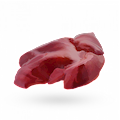Ciğer kebabı
Ciğer kebabı, or liver kebab, is a popular Turkish dish of skewered and grilled liver originating from southeastern Turkey, particularly Diyarbakır, Gaziantep, and Şanlıurfa. It is popularly enjoyed in southern provinces and holds cultural significance.
It is also often served for breakfast. Preparation involves cutting and seasoning the liver with salt, spices, and sometimes vegetables and skewering it with tail fat. In Gaziantep, the liver is cubed and skewered, while in Mersin, Adana, and Şanlıurfa, it is threaded in smaller pieces using special liver skewers, often alternating with tail fat in Gaziantep.
In Urfa, the skewers are wrapped in tail fat. Serving methods vary: it may be garnished with parsley and onion and seasoned with cumin or also accompanied by lavash bread. In Gaziantep, it is served directly on skewers with bread, accompanied by ornamental pepper and lemon. Read more
Roasted green peppers and tomatoes also often accompany the skewers. Historically, ciğer kebabı is detailed in Ottoman cookbooks such as Melceü't-Tabbâhîn, describing sheep and lamb liver skewered and cooked over fire, seasoned with garlic, vinegar, water, and salt.
Regionally, varieties include Urfa liver kebab and Diyarbakır liver kebab, each recognized with geographical indications, highlighting their unique local flavors and traditional preparation methods.









